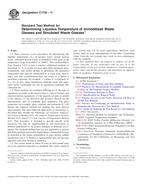Potřebujeme váš souhlas k využití jednotlivých dat, aby se vám mimo jiné mohly ukazovat informace týkající se vašich zájmů. Souhlas udělíte kliknutím na tlačítko „OK“.
ASTM C1720-11
Standard Test Method for Determining Liquidus Temperature of Immobilized Waste Glasses and Simulated Waste Glasses
Automaticky přeložený název:
Standardní zkušební metoda pro stanovení teplotě likvidu imobilizovaných odpadu Sklo a simulované odpadů brýle
NORMA vydána dne 1.2.2011
Informace o normě:
Označení normy: ASTM C1720-11
Poznámka: NEPLATNÁ
Datum vydání normy: 1.2.2011
Kód zboží: NS-12302
Počet stran: 21
Přibližná hmotnost: 63 g (0.14 liber)
Země: Americká technická norma
Kategorie: Technické normy ASTM
Anotace textu normy ASTM C1720-11 :
Keywords:
calibration, gradient furnace, liquidus temperature, uniform, ICS Number Code 81.040.10 (Raw materials and raw glass)
Doplňující informace
| Significance and Use | ||||||||||||||
|
This procedure can be used for (but is limited to) the following applications: (1) support glass formulation development to make sure that processing criteria are met, (2) support production (for example, processing or troubleshooting), and (3) support model validation. |
||||||||||||||
| 1. Scope | ||||||||||||||
|
1.1 These practices cover procedures for determining the liquidus temperature (TL) of nuclear waste, mixed nuclear waste, simulated nuclear waste, or hazardous waste glass in the temperature range from 600°C to 1600°C. This method differs from Practice C829 in that it employs additional methods to determine TL. TL is useful in waste glass plant operation, glass formulation, and melter design to determine the minimum temperature that must be maintained in a waste glass melt to make sure that crystallization does not occur or is below a particular constraint, for example, 1 volume % crystallinity or T1%. As of now, many institutions studying waste and simulated waste vitrification are not in agreement regarding this constraint (1). 1.2 Three methods are included, differing in (1) the type of equipment available to the analyst (that is, type of furnace and characterization equipment), (2) the quantity of glass available to the analyst, (3) the precision and accuracy desired for the measurement, and (4) candidate glass properties. The glass properties, for example, glass volatility and estimated TL, will dictate the required method for making the most precise measurement. The three different approaches to measuring TL described here include the following: (A) Gradient Temperature Furnace Method (GT), (B) Uniform Temperature Furnace Method (UT), and (C) Crystal Fraction Extrapolation Method (CF). This procedure is intended to provide specific work processes, but may be supplemented by test instructions as deemed appropriate by the project manager or principle investigator. The methods defined here are not applicable to glasses that form multiple immiscible liquid phases. Immiscibility may be detected in the initial examination of glass during sample preparation (see 9.3). However, immiscibility may not become apparent until after testing is underway. 1.3 The values stated in either SI units or inch-pound units are to be regarded separately as standard. The values stated in each system may not be exact equivalents; therefore, each system shall be used independently of the other. Combining values from the two systems may result in non-conformance with the standard. 1.4 This standard does not purport to address all of the safety concerns, if any, associated with its use. It is the responsibility of the user of this standard to establish appropriate safety and health practices and determine the applicability of regulatory limitations prior to use. |
||||||||||||||
| 2. Referenced Documents | ||||||||||||||
|
Doporučujeme:
Aktualizace technických norem
Chcete mít jistotu, že používáte pouze platné technické normy?
Nabízíme Vám řešení, které Vám zajistí měsíční přehled o aktuálnosti norem, které používáte.
Chcete vědět více informací? Podívejte se na tuto stránku.




 Cookies
Cookies
